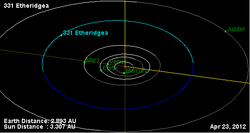Astronomy:331 Etheridgea
 Orbital diagram | |
| Discovery | |
|---|---|
| Discovered by | Auguste Charlois |
| Discovery date | 1 April 1892 |
| Designations | |
| (331) Etheridgea | |
| Pronunciation | /ˌɛθəˈrɪdʒiə/ |
| Named after | Possibly Robert Etheridge |
| Minor planet category | Main belt |
| Orbital characteristics[1] | |
| Epoch 31 July 2016 (JD 2457600.5) | |
| Uncertainty parameter 0 | |
| Observation arc | 123.95 yr (45,274 d) |
| |{{{apsis}}}|helion}} | 3.32623 astronomical unit|AU (497.597 Gm) |
| |{{{apsis}}}|helion}} | 2.72055 AU (406.988 Gm) |
| 3.02339 AU (452.293 Gm) | |
| Eccentricity | 0.10016 |
| Orbital period | 5.26 yr (1,920.2 d) |
| Mean anomaly | 88.5392° |
| Mean motion | 0° 11m 14.939s / day |
| Inclination | 6.05385° |
| Longitude of ascending node | 22.0346° |
| 333.055° | |
| Physical characteristics | |
| Dimensions | 74.92±2.7 km |
| Rotation period | 25.315 h (1.0548 d) |
| Geometric albedo | 0.0447±0.003 |
| Absolute magnitude (H) | 9.62 |
Etheridgea (minor planet designation: 331 Etheridgea) is a large main belt asteroid.[1] It was discovered by Auguste Charlois on 1 April 1892 in Nice. The meaning of the name is unknown.[2] This asteroid is orbiting the Sun at a distance of 3.02 astronomical unit|AU with a period of 5.26 years and an eccentricity (ovalness) of 0.10. The orbital plane is tilted at an angle of 6.05° to the plane of the ecliptic.[1]
Analysis of the asteroid light curve generated from photometric data collected in 2015 provided a rotation period of 25.315±0.001 h. This result is completely different from the previous rotation period estimates.[3] It is a low albedo, carbonaceous C-type asteroid and spans a girth of 74.9±2.7 km.[4]
It may have been named for the geologist and paleontologist Robert Etheridge (1819–1903).[5][6]
References
- ↑ 1.0 1.1 1.2 "331 Etheridgea". JPL Small-Body Database. NASA/Jet Propulsion Laboratory. https://ssd.jpl.nasa.gov/sbdb.cgi?sstr=331.
- ↑ Schmadel, Lutz D. (2009), Dictionary of Minor Planet Names, Addendum to Fifth Edition: 2006 - 2008, Springer, p. 217, ISBN 9783642019654, https://books.google.com/books?id=Ad4_AAAAQBAJ&pg=PA217
- ↑ Pilcher, Frederick (April 2016), "Rotation Period Determination for 269 Justitia, 275 Sapientia 331 Etheridgea, and 609 Fulvia", Bulletin of the Minor Planets Section of the Association of Lunar and Planetary Observers 43 (2): 135–136, Bibcode: 2016MPBu...43..135P.
- ↑ Fornasier, S. et al. (2014), "Aqueous alteration on main belt primitive asteroids: Results from visible spectroscopy", Icarus 233: 163–178, doi:10.1016/j.icarus.2014.01.040, Bibcode: 2014Icar..233..163F.
- ↑ "April 01 – Discovery of Asteroid 331 Etheridgea (1892)". 1 April 2020. https://iagout.wordpress.com/2020/04/01/april-01-331-etheridgea/.
- ↑ Room, A. (1988). Dictionary of Astronomical Names. United Kingdom: Routledge.
External links
- Lightcurve plot of 331 Etheridgea, Palmer Divide Observatory, B. D. Warner (1999)
- Asteroid Lightcurve Database (LCDB), query form (info )
- Dictionary of Minor Planet Names, Google books
- Asteroids and comets rotation curves, CdR – Observatoire de Genève, Raoul Behrend
- Discovery Circumstances: Numbered Minor Planets (1)-(5000) – Minor Planet Center
- 331 Etheridgea at AstDyS-2, Asteroids—Dynamic Site
- 331 Etheridgea at the JPL Small-Body Database
 |

